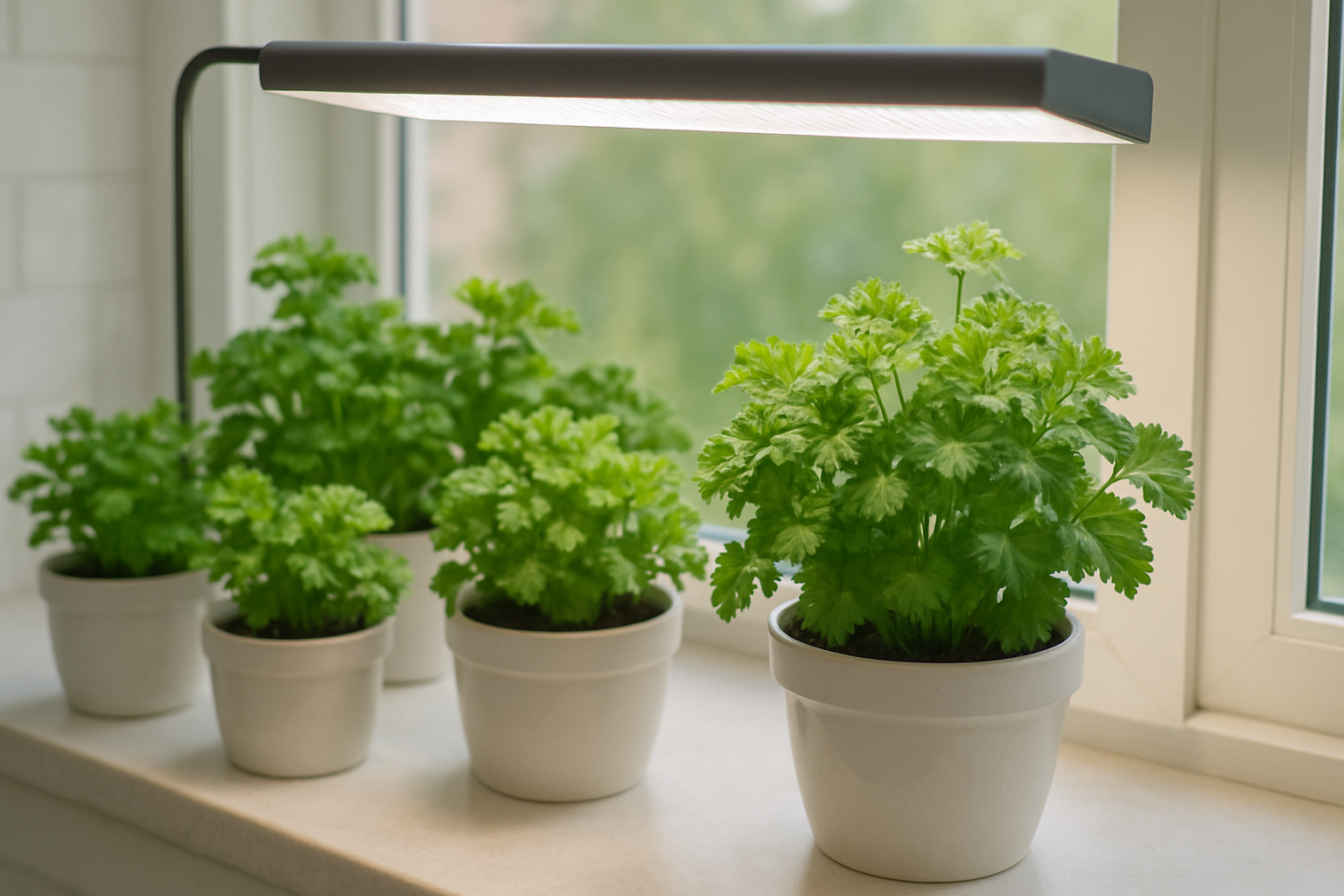Introduction
Successfully growing parsley under grow lights can make all the difference when cultivating this flavorful herb indoors. Without proper lighting, parsley often becomes leggy, pale, or slow to grow, leaving indoor gardeners frustrated with sparse harvests. Natural sunlight just isn’t strong or consistent enough inside most homes, especially during winter or in shady spaces. But by choosing the right grow lights and understanding how to use them, you can give your parsley the energy it needs to thrive year-round, producing lush, aromatic leaves for your kitchen.
In this post, we’ll explore why artificial lighting is essential for indoor parsley, the main challenges you might encounter without it, and real-world tips for selecting the best grow lights to maximize your parsley’s growth. You’ll learn how to set up your lights, how long to run them, and what features truly matter for healthy, vibrant parsley at home.
Understanding Parsley’s Light Needs
Parsley thrives best when given plenty of light, ideally six to eight hours of sunlight each day. If you’re growing parsley outdoors, choose a spot where it will receive morning sun but be shielded from harsh afternoon rays, as intense midday heat can cause the leaves to wilt.
Indoors, place your pot near a bright window where it gets indirect sunlight—light that fills a room but doesn’t hit the plant directly. This prevents leaf scorch while still providing the energy it needs to grow lush and green.
Natural light is always preferred, but it’s not always possible, especially in apartments, shaded homes, or during winter. In these cases, artificial grow lights are a reliable solution. LED grow lights designed for herbs can make a huge difference; position the light about 6 inches above the parsley and leave it on for 12–14 hours per day to mimic natural conditions.
Watch for common signs that your parsley isn’t getting enough light, such as leggy stems (long, thin, reaching for light), pale or yellowing leaves, and slow overall growth. If you notice your plant stretching towards windows or the leaves turning a dull green, these are clear cues to improve its lighting situation—either by moving it to a brighter spot or supplementing with grow lights.
By monitoring parsley’s reaction, you can adjust its environment and ensure it remains a vibrant, healthy addition to your indoor garden.
Types of Grow Lights for Parsley
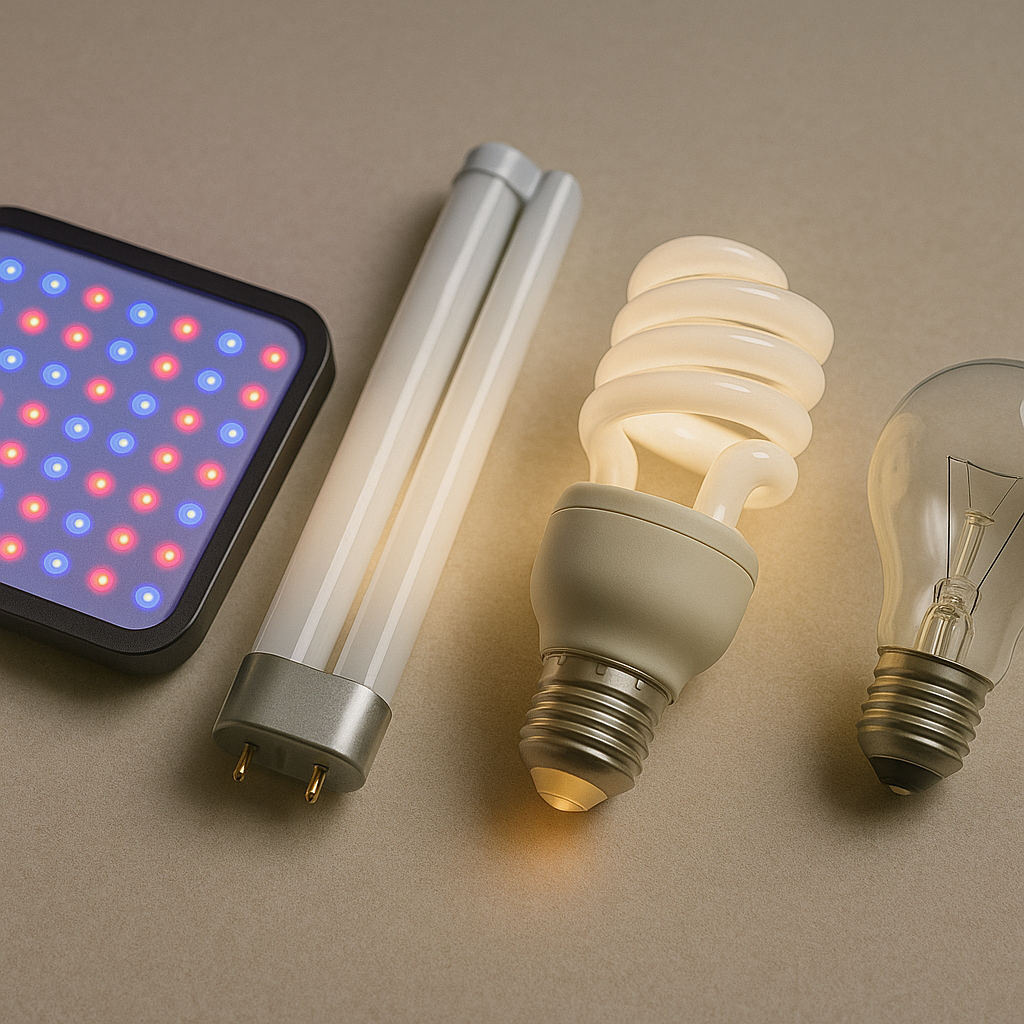
When choosing grow lights for parsley, it’s important to understand the key differences between LED, fluorescent, CFL, and incandescent options. LEDs (light-emitting diodes) lead the pack thanks to their energy efficiency, low heat output, and long lifespan—often 25,000 hours or more. They use less electricity than other types, keeping operating costs down and ensuring your parsley gets strong, targeted light without the risk of scorching.
Fluorescent lights, including classic T5 and T8 tubes, are another popular option for herbs. They’re budget-friendly upfront and deliver a broad spectrum of light, making them suitable for seed starting and leafy growth. However, they use more power than LEDs and last only about 7,000–10,000 hours.
Compact fluorescent lights (CFLs) offer similar advantages but work better for small spaces or as supplemental lighting. Still, they can’t match LEDs in efficiency, and over time, replacement costs add up.
Incandescent bulbs, on the other hand, are not recommended for parsley—they’re inefficient, produce excess heat, have short lifespans (usually 1,000 hours or less), and tend to foster leggy, weak growth due to their poor light spectrum.
Most gardeners today prefer LED grow lights for parsley because they combine cost savings and longevity with flexible setups, such as adjustable panels or strips that fit windowsills or shelving. While the initial investment for LEDs might be higher, their low energy use and infrequent replacement mean you’ll save money in the long run. For example, a basic LED grow light panel may cost $30–$50 and pay for itself in just a year compared to running fluorescents or replacing burnt-out bulbs.
In summary, for healthy, low-maintenance parsley year-round, LEDs deliver the best mix of light quality, energy economy, and durability.
How to Choose the Best Grow Light for Your Setup
When choosing the best grow light for your indoor garden, start by matching the wattage to your plant’s needs and available space. Smaller countertop herb gardens or shelf setups do well with LED grow lights in the 20-40 watt range, while larger hydroponic systems may require fixtures offering 100 watts or more.
Next, consider the light spectrum:
- Cool (blue) lights promote leafy growth, ideal for lettuce and herbs.
- Warm (red) lights stimulate flowering and fruiting for plants like tomatoes or peppers.
- Full-spectrum lights are a versatile option if you plan to grow a variety of plants, as they mimic natural sunlight and support all phases of growth.
Adjustability is another key factor; look for lights with adjustable height or brightness to adapt to plants as they grow, preventing leggy stems or light burn.
Make sure the fixture’s size and mounting options fit your space—clip-on or slim-bar LEDs are great for tight shelf setups, while larger panels work well above raised beds.
Remember to consider your growth goals:
- For greens or sprouts, a basic low-wattage full-spectrum LED is sufficient.
- For year-round fruiting or larger plants, invest in a higher-powered, dimmable light with robust cooling.
Don’t forget to factor in the distance from the light to the plant canopy; most lights need to sit 12-24 inches above the plants, so measure your growing area to avoid shadows or hotspots.
Lastly, opt for energy-efficient models to keep electricity costs down, and check for timers or smart controls if you want hassle-free automation.
With these factors in mind, you can match your grow light to your space and objectives, ensuring healthier plants and a flourishing indoor garden.
Setting Up Your Indoor Parsley Grow Station
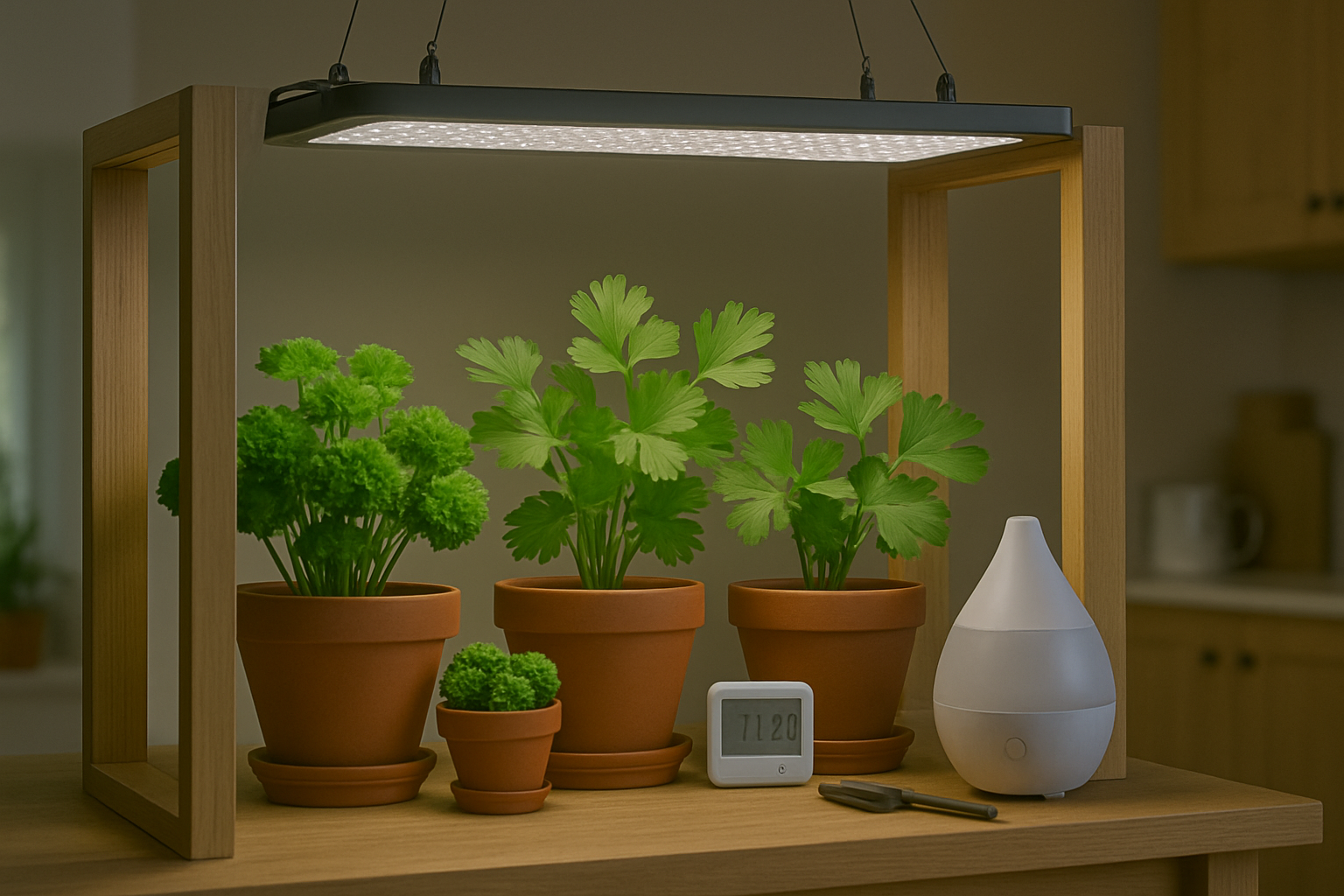
Setting up your indoor parsley grow station starts with choosing the right location—pick a spot with minimal drafts and stable indoor temperatures. Begin by assembling your grow lights, using LED or fluorescent fixtures designed specifically for plant growth, as these provide the right light spectrum without generating too much heat.
Hang your lights about 10 to 12 inches above the parsley’s highest leaves to prevent leaf burn and encourage healthy development. If your fixtures are adjustable, you can easily raise the lights as the plants grow taller. Arrange the lights to ensure even coverage, avoiding dark corners where plants may become spindly from lack of light.
For the best results, set your lights on an automatic timer—parsley thrives with about 12 to 16 hours of consistent light each day, mimicking long summer days. Adjust the timer as needed and check daily to ensure your lights are running on schedule.
Periodically rotate the pots or trays, or slightly shift the direction of the lights, to make sure every part of your parsley gets uniform exposure, rather than having new growth lean in one direction.
By fine-tuning your grow light setup—especially the distance, duration, and evenness of light—you create perfect conditions for your indoor parsley to thrive all year round, right in your kitchen or on a sunny windowsill.
Caring for Parsley Under Grow Lights
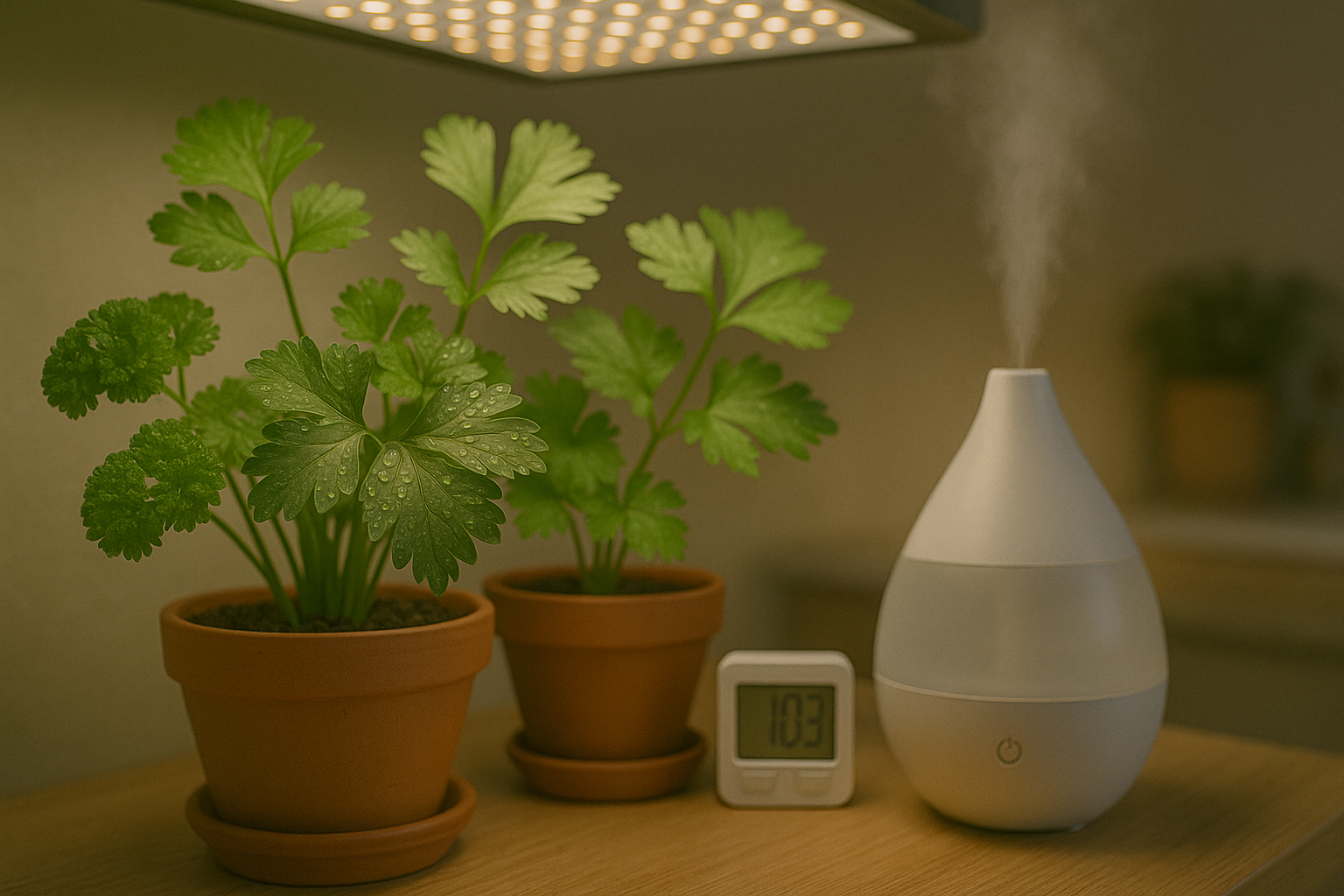
When growing parsley indoors under grow lights, maintaining the right moisture balance is key. Water your parsley regularly, but let the top inch of soil dry out between waterings to avoid soggy roots or fungal problems. Aim for moderate humidity levels (around 40–60%) by placing a small humidifier nearby or misting lightly, especially during dry winter months.
Keep the temperature in the “comfort zone” of 65–75°F, as parsley grows best within this range. Avoid placing pots near drafts or heating vents, which can stress the plant. Leaf burn is a common issue when grow lights are too close, so keep the lights 8–12 inches above the plant and adjust as your parsley matures.
If your parsley looks tall, thin, or “leggy,” it may not be getting enough light. Try extending the light duration or moving the lamp closer. Rotate your pots every few days to ensure even light exposure and prevent one-sided growth.
Take a few moments each week to check for yellowing leaves, pests, or mold, removing damaged foliage right away. By dialing in these conditions and staying observant, you’ll help your indoor parsley stay bushy, green, and full of flavor.
Top Recommended Grow Lights for Parsley
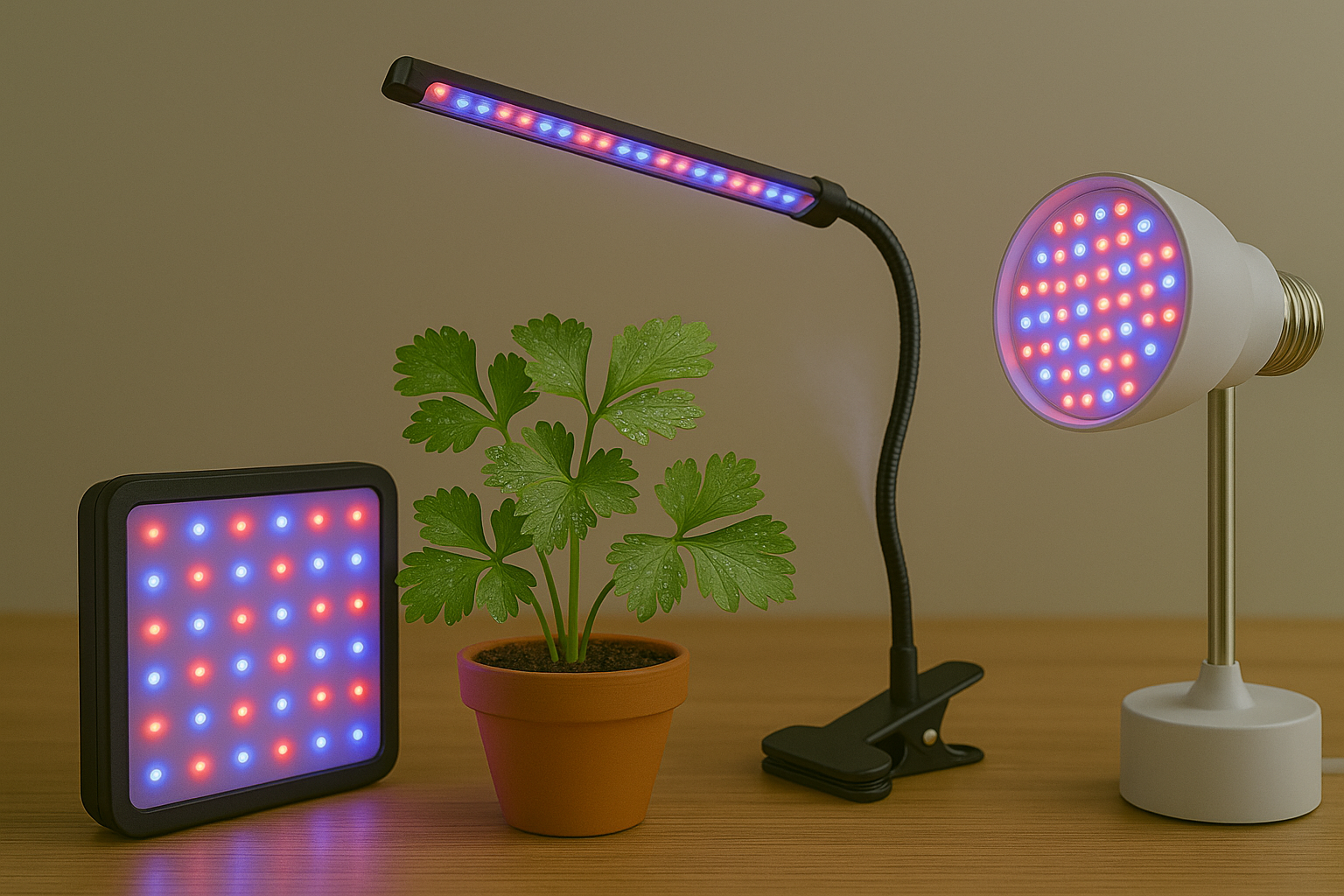
When choosing the best grow lights for parsley, a few standout models combine performance, affordability, and flexibility—perfect for home gardeners or hobbyists.
The Mars Hydro TS 600 LED is a popular pick, providing full-spectrum light that mimics sunlight to support both seedling and mature parsley growth. It features a thin, energy-efficient design that’s easy to fit above your plants, and its low power consumption keeps electricity costs down—ideal for those running their lights for 12-14 hours daily, as discussed earlier.
Another top option is the VIPARSPECTRA P600 LED Grow Light, which offers adjustable brightness settings, letting you tailor the intensity as your parsley transitions from sprouting to harvest. Its even light distribution ensures all your plants get equal coverage, preventing patchy growth.
For a more budget-friendly choice, the GE BR30 LED Grow Light Bulb can simply screw into existing fixtures, providing balanced spectrum light without fancy installation. This is a great solution for smaller setups or windowsill herb gardens.
All these models deliver the blue and red wavelengths crucial for parsley’s leafy development, aligning with best practices for indoor herb lighting.
When comparing grow lights, make sure to consider:
- The size of your growing space
- Desired yield
- How much you want to automate light cycles
Features like timers or dimmers can further streamline your setup and help parsley thrive year-round.
Conclusion
Choosing the right grow lights for indoor parsley is all about matching your plant’s needs with your space and budget. Opt for LED lights to save energy and provide the ideal spectrum. Keep your lights about 6–12 inches from your plants for optimal growth.
Remember, every indoor space is different—experiment with light duration, positioning, and watering to find what works best for your parsley. Don’t hesitate to tweak your setup as you go.
Have questions or want to share your own tips? Drop a comment below—I’d love to help and learn from your experiences!
